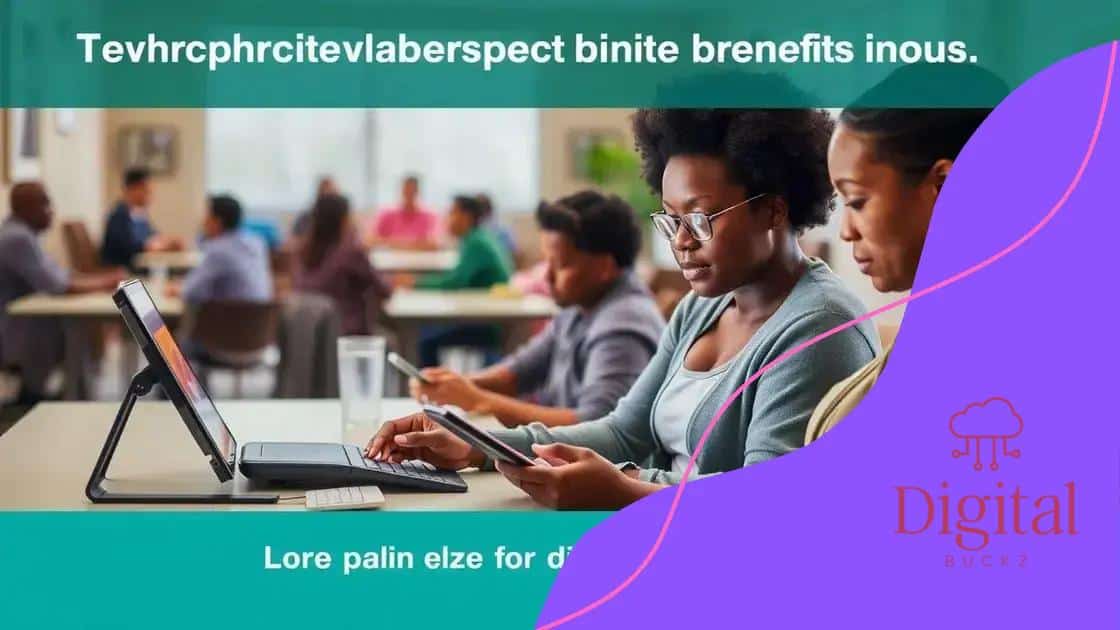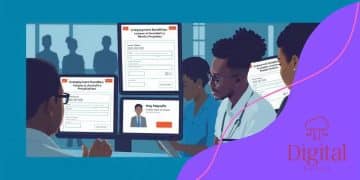The role of technology in improving public benefits distribution

The role of technology in improving public benefits distribution involves using innovative tools like AI and mobile applications to enhance accessibility, streamline processes, and ensure that services effectively meet the needs of all individuals.
The role of technology in improving public benefits distribution is more crucial than ever. Have you noticed how tech can change our access to important services? Let’s dive into its impact and what it means for you.
Understanding public benefits distribution
Understanding public benefits distribution is essential for realizing how technology can make this process smoother. These benefits include support for nutrition, health, and education.
Public benefits aim to support various segments of society, ensuring that everyone has access to vital services. When we look at traditional methods, they often seem outdated. Technology, however, offers innovative ways to streamline these processes.
Key Components of Public Benefits Distribution
To fully appreciate the impact of technology, we must first identify the main components of public benefits distribution. These components can impact how effectively services reach those in need.
- Eligibility Verification: Ensuring recipients meet requirement criteria.
- Application Process: Simplifying how individuals apply for benefits.
- Support Services: Offering guidance throughout the process.
- Monitoring and Reporting: Tracking the efficiency of distribution.
Each of these components plays a crucial role in maintaining the efficiency of public benefits. Focusing on user experience is essential. When an individual accesses these services, their satisfaction can lead to better outcomes.
One of the main advantages of technology is its ability to gather and analyze data quickly. This capability helps identify which areas need assistance the most. For instance, metrics on application times and approval rates can pinpoint inefficiencies, allowing programs to adapt accordingly.
How Technology Enhances Access
Technology increases accessibility for disadvantaged groups. Online applications reduce travel time and costs, making services more reachable. Mobile applications also enable users to check their benefits or receive updates in real-time.
Moreover, educational tools online can assist individuals in understanding their rights and available services. Enhancing digital literacy further empowers individuals to engage with these channels effectively. As the world becomes more digitized, it is crucial that everyone can participate and benefit.
How technology enhances accessibility
How technology enhances accessibility is a vital topic in modern society. Innovations are making essential services easier to use for everyone. With technology, barriers are breaking down, allowing individuals to access public benefits more effectively than ever.
Accessibility is not just about having services available; it is about making them user-friendly. For instance, mobile applications allow users to access their benefits anytime and anywhere, removing the need for long wait times in offices.
Key Features of Enhanced Accessibility
Modern technology introduces several key features that promote greater accessibility in public services.
- User-Friendly Interfaces: Simple designs help everyone navigate easily.
- Online Applications: Users can complete applications from their homes.
- Language Options: Multilingual support makes services accessible to non-native speakers.
- Real-Time Updates: Individuals can receive notifications and updates instantly.
The benefits of technology go beyond just convenience. They also include improved transparency. Online portals can show users their application status clearly, reducing anxiety and uncertainty.
Moreover, interactive tools can guide users through the process. For example, chatbots can answer common questions, making the experience smoother. Even individuals with disabilities find technology essential. Features such as voice commands and screen readers make it easier for everyone to engage with these services.
The Importance of Digital Literacy
To fully benefit from these technological advances, digital literacy becomes crucial. Individuals need to understand how to use these tools effectively. Community programs play an essential role in teaching these skills. By fostering digital confidence, more people can take advantage of services tailored for them.
When users feel empowered with knowledge, their interaction with public benefits improves remarkably. This leads to better outcomes and a more engaged public.
Examples of successful tech implementations

Examples of successful tech implementations show how technology can revolutionize public benefits distribution. Many organizations and governments have adopted digital solutions, leading to improved access and efficiency.
One notable example is the use of online platforms for benefits applications. These platforms allow users to apply for assistance quickly and easily from the comfort of their homes. By reducing the need for paperwork, these systems save time and effort for both applicants and agencies.
Case Studies of Effective Systems
Several case studies highlight the effectiveness of these digital solutions:
- California’s Benefits CalWIN: This online system streamlines the application process for various public assistance programs. Users can apply for food, health care, and cash assistance in one platform.
- New York City’s ACCESS NYC: By offering a comprehensive portal, residents can assess their eligibility and apply for multiple benefits, all in one place.
- UK’s Universal Credit: This system consolidates several welfare programs into a single payment, simplifying the process for recipients.
Through these implementations, we see how technology can overcome traditional barriers. Processes that once took weeks can now be completed in a matter of days, enhancing efficiency on all sides.
Moreover, successful tech implementations often include user feedback. By regularly updating their systems based on user experiences, agencies can continue to improve their services. For instance, simple adjustments like improving navigation and adding more languages can significantly impact accessibility.
Innovations in Data Management
Another area where technology shines is in data management. Automated systems can track applications and monitor outcomes without cumbersome manual processes. This data-driven approach helps agencies allocate resources more effectively, ensuring that those who need help receive it promptly.
Utilizing advanced analytics, organizations can understand patterns in applications and tailor their offerings. This not only enhances the user experience but also lets agencies respond to community needs proactively.
Challenges in tech adoption for public benefits
Challenges in tech adoption for public benefits can significantly hinder the effectiveness of programs aimed at helping those in need. While technology has the potential to make the distribution of benefits more efficient, various obstacles can complicate its implementation.
One primary challenge is the digital divide. Many individuals lack access to the internet or smartphones, which limits their ability to use online platforms. This issue can be especially pronounced in rural areas, where connectivity can be unreliable or unavailable.
Key Barriers to Tech Adoption
Several key barriers impact the adoption of technology in public benefits:
- Lack of Training: Users may not know how to navigate digital systems effectively.
- Resistance to Change: Some organizations may be hesitant to abandon traditional methods.
- Data Privacy Concerns: Recipients worry about how their personal information is handled.
- Budget Constraints: Limited funds may restrict technology updates and maintenance.
Additionally, growing skepticism about technology can make the implementation process difficult. Users may fear that online systems may not be reliable or could lead to mistakes in their benefits. This skepticism can be detrimental, as it may prevent people from engaging with the very systems designed to help them.
Another significant challenge is ensuring user-friendly design. If an application or website is difficult to navigate, users may become frustrated and give up. Ensuring that interfaces are intuitive is crucial for successful tech adoption.
Organizational Resistance
Organizations may also experience resistance to adopting new technologies. Employees may require training to transition from paper-based processes to digital systems. Without adequate support, staff may feel overwhelmed by the change.
Moreover, regulatory hurdles can create barriers to tech adoption. Organizations must comply with legal requirements that may slow down the implementation of new technologies. These complexities can hinder the rapid progress needed to adapt to a changing landscape.
The future of technology in public benefits
The future of technology in public benefits looks promising, with innovative solutions on the horizon. As society continues to evolve, technology will play a greater role in how benefits are distributed and managed. New advancements can lead to more accessible and efficient systems.
One major trend is the use of artificial intelligence (AI). AI can help analyze data more effectively, allowing for faster processing of applications. This means that eligible individuals can receive assistance without unnecessary delays. AI can also assist in fraud detection, ensuring that resources are allocated to those who truly need them.
Emerging Technologies Shaping Public Services
Various emerging technologies are set to enhance public benefits further:
- Blockchain: This technology can create transparent records of transactions, ensuring that benefits distribution is secure and traceable.
- Mobile Applications: User-friendly apps can provide real-time updates on benefits and application statuses, empowering individuals to stay informed.
- Data Analytics: Advanced analytics can help tailor services to meet community needs, making programs more effective.
- Telehealth Services: For health benefits, telehealth can provide easy access to medical consultations, reducing barriers for underserved populations.
The integration of these technologies can also aid in outreach efforts. By utilizing social media and targeted messaging, agencies can connect with those who may not be aware of available services. This approach ensures that information reaches the right audience, promoting greater utilization of public benefits.
Challenges and Opportunities Ahead
However, the future won’t be without challenges. Ensuring equitable access to technology remains a priority. Many individuals still struggle with digital literacy and have limited access to devices. Addressing these issues will be crucial in making the most out of technological advancements.
Despite the challenges, the opportunities for enhancing public benefits through technology are vast. Agencies can work to create systems that not only serve current needs but are also adaptable to future demands. Encouraging community involvement in shaping these technologies can lead to better outcomes and increased trust in public services.
In conclusion, technology is reshaping the landscape of public benefits distribution in exciting ways. As we embrace new tools like AI and mobile applications, we can streamline processes and improve accessibility for everyone. However, challenges remain, such as ensuring equitable access and addressing digital literacy gaps. By focusing on community needs and promoting user-friendly solutions, we can create an efficient system that truly serves all individuals. The future holds promise, and with continued innovation, we can enhance public services for years to come.
FAQ – Frequently Asked Questions about Technology in Public Benefits
How does technology improve public benefits distribution?
Technology streamlines processes, making applications faster and easier to access for everyone.
What role does AI play in public benefits?
AI helps analyze data quickly, improves application processing, and enhances fraud detection.
Why is addressing the digital divide important?
Ensuring everyone has access to the internet and devices is crucial for effective tech adoption in public services.
How can community involvement enhance technology adoption?
Engaging communities ensures that technologies meet the actual needs of users, leading to better outcomes.






